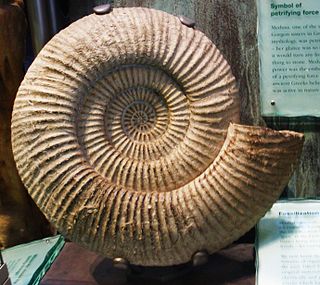Anaklinoceras is a genus of extinct heteromorph ammonite cephalopod that lived in marine environments in what is now Western North America during the Campanian division of the Cretaceous period. Their shells were very similar to the related ammonites of the genus Ainoceras, where the young ammonite's shell coiled helically, and upon reaching adulthood, the youngest coil arched over the older coils.
Sundayichthys is an extinct genus of prehistoric bony fish.

Phylloceras is an extinct genus of ammonoid cephalopods belonging to the family Phylloceratidae. These nektonic carnivores lived from Early Jurassic to Late Cretaceous.

Tarasiiformes is an extinct order of prehistoric ray-finned fish.

Desmoceras is a genus of ammonites belonging to the family Desmoceratidae. These cephalopods were fast-moving nektonic carnivores. They lived in the Early Cretaceous; Albian epoch.

Pachydesmoceras is a genus of ammonites belonging to the family Desmoceratidae.

Calycoceras is an extinct genus of cephalopods belonging to the subclass Ammonoidea and family Acanthoceratidae that lived during the Cenomanian stage of the Late Cretaceous, 100-94 Mya. Their shells had ornate ribs.

Birmanites is a genus of trilobites in the order Asaphida, family Asaphidae.

Belemnites is a genus of an extinct group of cephalopods belonging to the order Belemnitida. These cephalopods existed in the Early Jurassic period from the Hettangian age to the Toarcian age (175.6–183.0). They were fast-moving nektonic carnivores.

Strophomena is a genus of brachiopods belonging to the order Strophomenida family Strophomenidae, named by Rafinesque in 1824. They were stationary epifaunal suspension feeders.

Ampullina is an extinct taxonomic genus of deep-water sea snails, marine gastropod molluscs in the clade Caenogastropoda. These sea snails were epifaunal grazers. They lived from the Middle Triassic period to the Lower Pliocene age.

Lopha is a genus of marine bivalve molluscs in the family Ostreidae.

Titanites is an extinct ammonite cephalopod genus within the family Dorsoplanitidae, that lived during the late Tithonian of the Late Jurassic.

Pleuroceras is a genus of ammonite from the lower Jurassic, upper Pliensbachian.
Neophylloceras is an extinct genus of cephalopod belonging to the Ammonite subclass.

Metoioceras is an extinct genus of cephalopod belonging to the Ammonite subclass which lived during the Cenomanian.

Pterotrigonia is an extinct genus of saltwater clams, marine bivalve molluscs in the family Megatrigoniidae. This genus is known in the fossil record from the Jurassic period Tithonian age to the Cretaceous period Maastrichtian age. Species in this genus were facultatively mobile infaunal suspension feeders. The type species of the genus is Pterotrigonia cristata.

Baluchicardia is an extinct genus of fossil saltwater clams, marine bivalve molluscs in the family Carditidae. These clams were facultatively mobile infaunal suspension feeders.
Radstockiceras is an extinct genus of lower Jurassic ammonite that lived from Oxynotum zone of upper Sinemurian to Raricostatum zone of lower Pliensbachian. Shells of these animals were oxycone and involute with umbilicus that took maximum of 12% of diameter in the case of outer whorls. On inner whorls, venter has been sharp, but then it became rounded. Faint ribs had falcoid shape, but sometimes, ribs could absent. Shells could have been large in their size. Suture has been very complex, similar to Oxynoticeras, but culmination at umbilical margin has been missing. Genus has been named after town of Radstock, in Somerset.
Reynesocoeloceras is genus of ammonite that lived during the lower Pliensbachian stage of early Jurassic, ammonite zones Ibex—Davoei.















